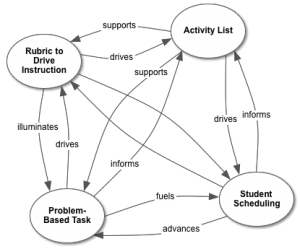Albert Einstein is credited with saying, “I never teach my pupils; I only attempt to provide the conditions in which they learn.” This speaks of the shift from teacher as the purveyor of information to that of an architect of a complex environment in which students learn; a shift from “teacher as ferry” to “teacher as bridge builder.” How does one create the conditions under which students learn?
Schools place considerable focus on best practices, which are necessary but not sufficient for creating the conditions under which students learn. Best practices are often approached as individual strategies for supporting student learning. Consider some best practices that would create the conditions under which students learn:
- Using problem-based learning to launch a unit of study creates a “felt need” for students to learn, thus motivating them to pursue curricular goals.
- Using an analytic rubric to provide students with clearly articulated expectations offers them a sense of responsibility for self-assessing, setting goals, and pursuing
 those goals.
those goals. - Developing a set of rich and diverse opportunities to learn, including multiple pathways to the same objective, based on learning modalities, provides students with the differentiation necessary to ensure that all students learn at high levels.
- Allowing students to schedule their own time empowers them to make decisions about when and how they will pursue individual learning goals.
These seem like worthy practices; however, the power of these practices lies in their interconnectedness, their interdependence. The key to creating the conditions under which students learn is in creating a systems-based classroom.
Consider the four best practices mentioned above. Teachers can build their ability to employ each of these, and, no doubt, this would enhance the instructional process. However, looking at these practices as independent strategies or structures falls short of creating the conditions under which students learn. What is needed is systems thinking: How does each component of the classroom affect every other component of the classroom?

To determine the health of a system, you look not at the nodes; you look at the lines. It is in the interdependencies that one creates a strong, effective system for learning.
For illustrative purposes, this diagram presents just four of the structures of the Learner-Active, Technology-Infused Classroom, designed to put students in charge of their own learning by creating the conditions under which they learn. The actual system includes many more nodes and lines. In order for students to take charge of their own learning, teachers must view the classroom as a self-sustaining, interdependent system.
First, think about the classroom as a system of interdependent components and identify the relationships among the components. You can then start building a system that removes the teacher from the position of “ferry master” and, instead, creates the conditions under which students learn.
